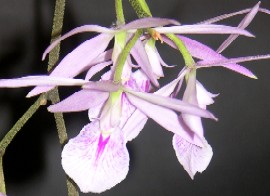

Orchid Watering Guide
Orchids are, for the most part, tolerant and resilient plants. Some can be found living in full sun, while just a few yards away the same species is living in complete shade. Many orchids survive in conditions that range from flood to drought.
When looking at the watering needs of orchids in your garden, you must take into consideration seasonal adjustments as well as the type of orchid and whether it is potted or mounted. The information and guidelines below are to be considered a starting point.
A word about rainwater. Rain contains a little bit of nitrogen, a fertilizer that promotes and encourages growth in plants. Fresh rainwater is beneficial to all your plants. Collected rainwater however, will lose much of its nitrogen in less than 24 hours.
Terrestrial Orchids - Rainy Season
These orchids grow in the ground. In the wild they could be underwater for hours at a time. During rainy season, allow your terrestrial orchids a full complement of rainwater, but be sure that they have adequate drainage. Being underwater for too long could severely damage or kill your plants.
Terrestrial Orchids - Dry Season
When the rains have stopped and the ground starts to dry out, most terrestrial orchids will die back. The plant isn’t dead; it’s just in its dormant stage, which could last six to nine months. During this stage of its life, the bulbs or corms (the part that is underground) are gathering strength, building up its resources, forming new bulbs or corms, and preparing new stems for the upcoming season. During this period of its life, they need a little water. But only a little water. Allow the top of the soil to get dry, but not so dry that it pulls away from the sides of the pot. Water the plant sparingly, and only occasionally.
Potted Orchids - Rainy Season
Allow your potted orchids to have the benefit of rainwater, but only occasionally. After being rained on for one night, move them to a sheltered area where they still have light and air flow, but are protected from the rain. Once or twice a week, check the potting material with a wooden stick (long toothpick, skewer or chopstick). If the stick indicates the potting material is dry, it’s time to move your plant into the open where it can again receive some rain.
Potted Orchids - Dry Season
Potted orchids can be very tolerant of drought conditions. Once or twice a week, check the potting material with a wooden stick (long toothpick, skewer or chopstick). If the stick indicates the potting material is dry, it’s time to water.
Mounted Orchids - Rainy Season
Most epiphytic and lithophytic orchids enjoy rainy season in the wild. This is when they show significant growth. Allow your mounted orchids to receive all the rainwater they can absorb. The only words of caution are: (1) make sure your plants have adequate airflow, (2) make sure your plants have adequate drainage, and (3) if there are 2 or more days of rain without sun or breezes, take measures to dry the roots of your plants.
Mounted Orchids - Dry Season
In the wild, orchids are usually found near streams, rivers, or other bodies of water. During the dry season, these water sources are the life blood of wild orchids during dry season. At night, especially during the early morning hours, the water is warmer than the air and a mist rises from the water. This mist settles on rock and tree surfaces as dew. This very small amount of water is all that orchids need to survive the dry season.
In your garden, if your orchids are exposed to the morning dew, the need to water them can be significantly reduced or eliminated. However, in the absence of this moisture, your orchid garden does need to be watered very lightly and occasionally.
Associated Problems
Excess Watering
Excess watering can cause waterlogged roots. Roots that are wet for too long can develop fungus, mold or bacterial infections. Potted plants are especially susceptible to this, but it can occur in mounted plants also. It is important to allow the roots of orchids to dry out between waterings. Under adverse conditions, it might be necessary put a fan in the area of your orchids to help the drying process.
Insufficient Watering
Insufficient watering can lead to chemical buildup. Tap water contains dissolved minerals. If these chemicals are not flushed out periodically, they can act as poisons. When watering, either potted or mounted plants, use sufficient water to flush out any built up minerals.
Rainwater can also contain dissolved minerals. Near the coast, rain can contain a small amount of salt. Elsewhere, chemicals that are in the atmosphere (like from fires) can end up in rainwater. Rainwater that is saved, and allowed to evaporate, can result in a concentration of these chemicals. Again, when watering, either potted or mounted plants, use sufficient water to flush out any built up minerals.